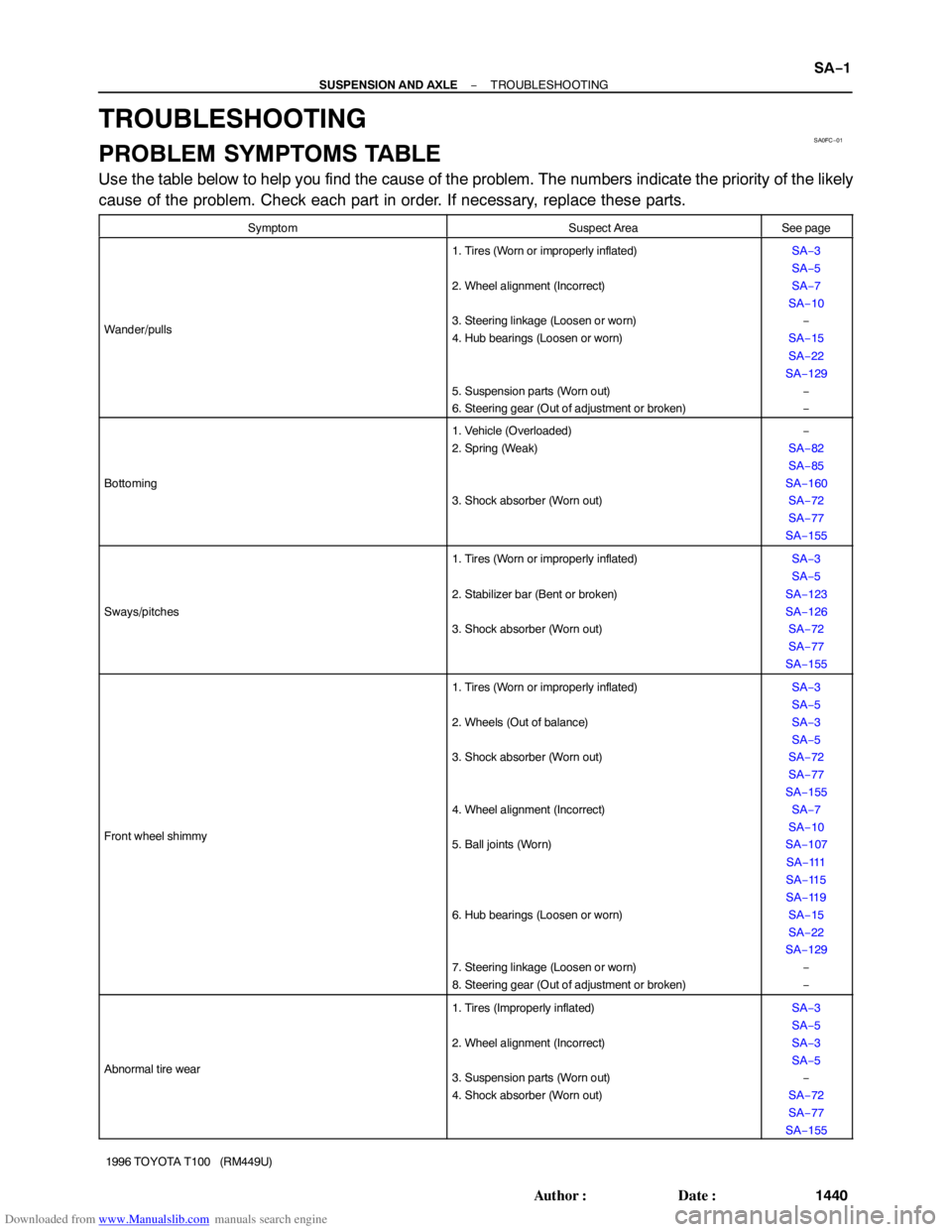Page 1467 of 2062

Downloaded from www.Manualslib.com manuals search engine R16053
R04428
PR−20
− PROPELLER SHAFTSPIDER BEARING
1438 Author�: Date�:
1996 TOYOTA T100 (RM449U)
2WD (TMC−made) and 4WD:
ColorMarkThickness mm (in.)
−12.100 − 2.150
(0.0827 − 0.0846)
−22.150 − 2.200
(0.0846 − 0.0866)
−32.200 − 2.250
(0.0866 − 0.0886)
Brown−2.250 − 2.230
(0.0886 − 0.0906)
Blue−2.300 − 2.350
(0.0906 − 0.0925)
−62.350 − 2.400
(0.0925 − 0.0945)
−72.400 − 2.450
(0.0945 − 0.0965)
−82.450 − 2.500
(0.0965 − 0.0984)
2WD (DANA−made):
ColorThickness mm (in.)
Green1.384 (0.0545)
Red1.435 (0.0565)
Black1.486 (0.0585)
Copper1.511 (0.0595)
Silver1.537 (0.0605)
Yellow1.588 (0.0625)
Blue1.638 (0.0645)
(b) Using a hammer, tap the yoke until there is no clearance
between the bearing outer race and snap ring.
7. CHECK SPIDER BEARING
(a) Check that the spider bearing moves smoothly.
(b) Check the spider bearing axial play.
Bearing axial play: Less than 0.05 mm (0.0020 in.)
HINT:
Install new spider bearings on the flange side in the procedure
described above.
Page 1471 of 2062

Downloaded from www.Manualslib.com manuals search engine SA0FC−01
− SUSPENSION AND AXLETROUBLESHOOTING
SA−1
1440 Author�: Date�:
1996 TOYOTA T100 (RM449U)
TROUBLESHOOTING
PROBLEM SYMPTOMS TABLE
Use the table below to help you find the cause of the problem. The numbers indicate the priority of the likely
cause of the problem. Check each part in order. If necessary, replace these parts.
SymptomSuspect AreaSee page
Wander/pulls
1. Tires (Worn or improperly inflated)
2. Wheel alignment (Incorrect)
3. Steering linkage (Loosen or worn)
4. Hub bearings (Loosen or worn)
5. Suspension parts (Worn out)
6. Steering gear (Out of adjustment or broken)SA−3
SA−5
SA−7
SA−10
−
SA−15
SA−22
SA−129
−
−
Bottoming
1. Vehicle (Overloaded)
2. Spring (Weak)
3. Shock absorber (Worn out)−
SA−82
SA−85
SA−160
SA−72
SA−77
SA−155
Sways/pitches
1. Tires (Worn or improperly inflated)
2. Stabilizer bar (Bent or broken)
3. Shock absorber (Worn out)SA−3
SA−5
SA−123
SA−126
SA−72
SA−77
SA−155
Front wheel shimmy
1. Tires (Worn or improperly inflated)
2. Wheels (Out of balance)
3. Shock absorber (Worn out)
4. Wheel alignment (Incorrect)
5. Ball joints (Worn)
6. Hub bearings (Loosen or worn)
7. Steering linkage (Loosen or worn)
8. Steering gear (Out of adjustment or broken)SA−3
SA−5
SA−3
SA−5
SA−72
SA−77
SA−155
SA−7
SA−10
SA−107
SA−11 1
SA−11 5
SA−11 9
SA−15
SA−22
SA−129
−
−
Abnormal tire wear
1. Tires (Improperly inflated)
2. Wheel alignment (Incorrect)
3. Suspension parts (Worn out)
4. Shock absorber (Worn out)SA−3
SA−5
SA−3
SA−5
−
SA−72
SA−77
SA−155
Page 1473 of 2062
Downloaded from www.Manualslib.com manuals search engine SA0FD−01
R03031
R12682
R07928
− SUSPENSION AND AXLETIRE AND WHEEL (2WD)
SA−3
1442 Author�: Date�:
1996 TOYOTA T100 (RM449U)
TIRE AND WHEEL (2WD)
INSPECTION
1. INSPECT TIRE
(a) Check the tires for wear and proper inflation pressure.
Cold tire inflation pressure
For driving under 120 km/h (75 mph).
Tire sizeFront
kPa (kg/cm2, psi)
Rear
kPa (kg/cm2, psi)
P215/75R15230 (2.3, 33)240 (2.4, 35)
P235/75R15
(0.5 ton)180 (1.8, 26)200 (2.0, 29)
P235/75R15
(1.0 ton)180 (1.8, 26)280 (2.8, 41)
(b) Check the tire runout.
Tire runout: 3.0 mm (0.118 in.) or less
2. ROTATING TIRES
HINT:
See the illustration for where to rotate each tire.
3. INSPECT WHEEL BALANCE
(a) Check and adjust the Off−the−car balance.
(b) If necessary, check and adjust the On−the−car balance.
Unbalance after adjustment: 14.0 g (0.031 lb) or less
Page 1474 of 2062
Downloaded from www.Manualslib.com manuals search engine R04258
SA−4
− SUSPENSION AND AXLETIRE AND WHEEL (2WD)
1443 Author�: Date�:
1996 TOYOTA T100 (RM449U)
4. CHECK WHEEL BEARING LOOSENESS
Check the backlash in the bearing shaft direction.
Maximum: 0.05 mm (0.0020 in.)
5. CHECK FRONT SUSPENSION FOR LOOSENESS
6. CHECK STEERING LINKAGE FOR LOOSENESS
7. CHECK BALL JOINT FOR LOOSENESS
8. CHECK SHOCK ABSORBER WORKS PROPERLY
�Check for oil leaks.
�Check mounting bushings for wear.
�Check front and rear of the vehicle for bounce.
Page 1475 of 2062
Downloaded from www.Manualslib.com manuals search engine SA0FE−02
R03031
R12682
R07928
− SUSPENSION AND AXLETIRE AND WHEEL (4WD)
SA−5
1444 Author�: Date�:
1996 TOYOTA T100 (RM449U)
TIRE AND WHEEL (4WD)
INSPECTION
1. INSPECT TIRE
(a) Check the tires for wear and for the proper inflation pres-
sure.
Cold tire inflation pressure
For driving under 120 km/h (75 mph).
Tire sizeFront
kPa (kg/cm2, psi)
Rear
kPa (kg/cm2, psi)
P235/75R15180 (1.8, 26)200 (2.0, 29)
31 x 10.5 R15LT180 (1.8, 26)200 (2.0, 29)
31 x 10.5 R15LT
Extra cab200 (2.0, 29)240 (2.4, 35)
(b) Check the tire runout.
Tire runout: 3.0 mm (0.118 in.) or less
2. ROTATING TIRES
HINT:
See the illustration for where to rotate each tire.
3. INSPECT WHEEL BALANCE
(a) Check and adjust the Off−the−car balance.
(b) If necessary, check and adjust the On−the−car balance.
Unbalance after adjustment: 14.0 g (0.031 lb) or less
Page 1476 of 2062
Downloaded from www.Manualslib.com manuals search engine SA−6
− SUSPENSION AND AXLETIRE AND WHEEL (4WD)
1445 Author�: Date�:
1996 TOYOTA T100 (RM449U)
4. CHECK FRONT SUSPENSION FOR LOOSENESS
5. CHECK STEERING LINKAGE FOR LOOSENESS
6. CHECK BALL JOINT FOR LOOSENESS
7. CHECK SHOCK ABSORBER WORKS PROPERLY
�Check for oil leaks.
�Check mounting bushings for wear.
�Check front and rear of the vehicle for bounce.
Page 1477 of 2062

Downloaded from www.Manualslib.com manuals search engine R12919
R12268F01731
A
B
C
D Front
Rear
SA0FF−02
Z03382
− SUSPENSION AND AXLEFRONT WHEEL ALIGNMENT (2WD)
SA−7
1446 Author�: Date�:
1996 TOYOTA T100 (RM449U)
FRONT WHEEL ALIGNMENT (2WD)
INSPECTION
HINT:
For the vehicle height of non−loaded vehidles for each model
and alighment standed values, refer to page SA−11 9.
1. MEASURE VEHICLE HEIGHT
Vehicle height: See page SS−58
Front: A − B = 74.0 mm (2.913 in.)
Rear: C − D = Standed cab
0.5 ton: 122.0 mm (4.803 in.)
1.0 ton: 107.0 mm (4.213 in.)
Extre cab: 115.5 mm (4.547 in.)
Measuring points:
A: Steering knuckle height measured at its center on
the outer edge.
B: Lower suspension arm front adjusting bolt height
measured at its center.
C: Rear axle shaft height measured at its center.
D: Rear leaf spring front bushing height measured at
its center.
NOTICE:
Before inspecting the wheel alignment, adjust the vehicle
height to specification.
If the vehicle height is not standard, try to adjust it by pushing
down on or lifting the body.
2. INSTALL CAMBER−CASTER−KINGPIN GAUGE OR
ONTO WHEEL ALIGNMENT TESTER
Follow the specific instructions of the equipment manufacturer.
3. INSPECT CAMBER, CASTER AND STEERING AXIS
INCLINATION
Camber
Left−right error0°00’ ± 45’ (0° ± 0.75°)
45’ (0.75°) or less
Caster
Left−right error4°00’ ± 45’ (4° ± 0.75°)
45’ (0.75°) or less
Steering axis inclination
Left−right error12°30’ ± 45’ (12.5° ± 0.75°)
45’ (0.75°) or less
If the steering axis inclination is not as specified, after camber
and caster have correctly adjusted, recheck the steering
knuckle front wheel for bearing or looseness.
Page 1478 of 2062

Downloaded from www.Manualslib.com manuals search engine SA3213
A
FrontB
C D
FA0014R05239F01733
R04256
R04257
SA−8
− SUSPENSION AND AXLEFRONT WHEEL ALIGNMENT (2WD)
1447 Author�: Date�:
1996 TOYOTA T100 (RM449U)
4. INSPECT TOE−IN
To e−in (total)
STD cabA + B: 0° ± 12’ (0° ± 0.2°)
C − D: 0 ± 2 mm (0 ± 0.08 in.)
Extra cab
P215/75 R15A + B: 0°22’ ± 12’ (−0.36° ± 0.2°)
C − D: −4.7 ± 2 mm (0.18 ± 0.08 in.)
Extra cab
P235/75 R15A + B: 0°22’ ± 12’ (0.36° ± 0.2°)
C − D: −4.9 ± 2 mm (0.19 ± 0.08 in.)
If the toe−in is not within the specification, adjust the rack end.
5. ADJUST CAMBER AND CASTER
HINT:
Try to adjust the camber and caster to center value.
If camber or caster is not within the specification, adjust by ad-
ding or removing shims on the upper suspension arm.
Shim thickness
4.0 mm (0.157 in.)1.6 mm (0.063 in.)1.2 mm (0.047 in.)
HINT:
If the steering axis inclination is not as specified after camber
and caster have been correctly adjusted, recheck the steering
knuckle and front wheel for distortion or looseness.
NOTICE:
Adjust the shim thickness to 7 mm (+4, −3), and adjust the
difference between the front and rear of the upper suspen-
sion arm shaft to within 4 mm.
If this adjustment is not possible, adjust the strut bar bush
set nut.
6. ADJUST TOE−IN
(a) Remove the boot clamps.
(b) Loosen the tie rod end lock nuts.
(c) Turn the left and right rack ends an amount to adjust the
toe−in.
HINT:
�Try to adjust the toe−in to the center value.
�Make sure that the length of the left and right rack ends
are the same.
Rack end difference: 3.0 mm (0.118 in.) or less
(d) Tighten the tie rod end lock nut.
Torque: 56 N·m (570 kgf·cm, 41 ft·lbf)
(e) Place the boot on the seat and install the clip.
HINT:
Make sure that the boots are not twisted.